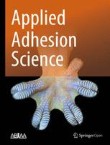Influences of the pH on the adsorption properties of an antimicrobial peptide on titanium surfaces
The adsorption behavior of the Tet-124 antimicrobial peptide and the Tet-124 peptide modified at the C- and N-terminus with the sequence glycine-3,4-dihydroxyphenylalanine-glycine (G-DOPA-G) on titanium surfac...
